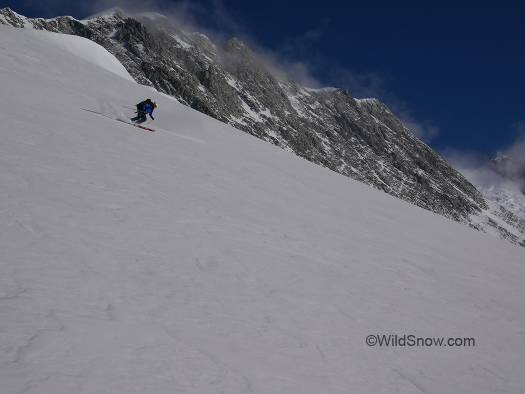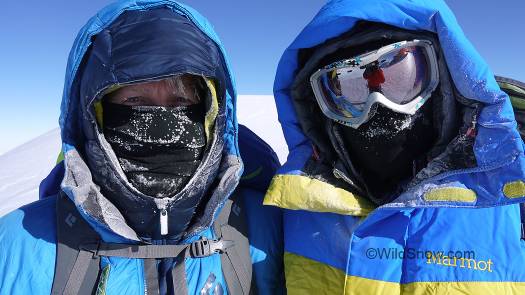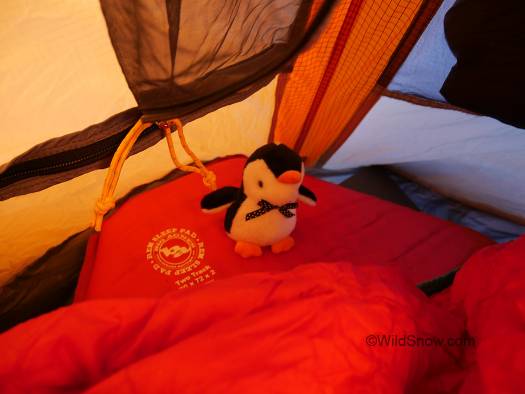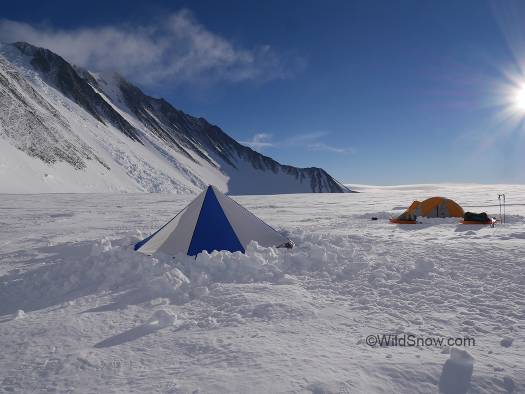Vinson Massif, Antarctica
The keys to great trips, whether a day in the mountains, weekend hut trip or expedition are choosing the right partners and being dialed on your gear.
On a recent trip to Vinson Massif, it was the little things that shifted our minds away from severe cold and suffering to cozy camping and comfort on the hill and in the tent.
Here’s a list of some of the kit that kept us warm and snug between 0 centigrade and –40C.
Hands, head and feet
Tip: Getting warm in the morning is priority #1. Then during the day you want to layer to stay on the edge of warm and cold and thus not perspire. If you’ve got good blood circulation, temperature regulation can be done via your extremities — specifically your head, hands and feet (mainly, your head). But working with your torso layering is key as well.
Gloves — I carried a light liner, light and heavy leather style work gloves and a super warm mitt. Specifically: Black Diamond Rambla, Guide glove and Absolute mitt. Both my partners used the First Ascent Guide Glove which allows good dexterity and ample warmth. Shop for BD gloves.
Headwear — Since I’ve got enough hair for cranial sun protection I’m a fan of headbands (and tennis legend Bjorn Borg) as they vent super well but retain warmth. Assorted Buff style neck gaiters are key and double as a sleeping eye mask as Antarctica offers 24 hours of sunlight. I took an old Patagonia Highloft shell hat (so old I couldn’t find an image on the internet) along with a BD Balaclava as it offers full coverage over the nose. For a lightweight hat I also brought an old Cloudveil 4-Shadows Beanie made out of Scholler Dryskin which wicks and cuts wind but is low profile. Neoprene facemask is also a must.
Tip: Cut out the balaclava mouth area to allow eating drinking on the trail and improve airflow.
POC Iris goggles and Jeremy Jones Signature glacier glasses. These glasses are dark and steazy. Spare glasses were Revo Guide glasses.
Thermacell Heated footbeds (sold by WildSnow advertising partner 8k Peak), remote control heat at the touch of a button. They work, terrific in climbing/ski boots and around camp.
Tip: Thermacell footbeds warm up to body temp (keeps battery output good) and are easily regulated with the hand held remote. This is key because while chemical heat packs for hands and feet are good, being able to regulate warmth and not overheat or getting sweaty feet is important to multi-day warmth and comfort while logging miles.
La Sportiva Olympus Mons EVO – these things are MONEY.
BD Sabretooth crampons – great all around crampons. You want steel in cold temps and the Sabretooths are precise on mixed ground.
Forty Below Neoprene Overboots (for ski boots and around camp). Wildsnow has blogged about these and the modification you can make to accommodate tech bindings. Well worth warm toes.
Nutrition
Tip: we tried to eat as much as possible because battling cold temps burns calories. Easy to prepare foods that require little to no dish duty or clean up keep the calories flowing.
Penn’s special gorp – mix of shelled pistachios and chocolate covered espresso beans (protein, anti oxidants, fiber and caffeine).
Mix of cheeses, salami, proscuitto, crackers – real food tastes good.
Dinty Moores, Ramen, and Tasty Bites. Real bacon and burgers at base camp for the first and last days.
Couple of boxes of wine again at base camp , a flask of Genepi — c’est bon no?
Assortment of Honey Stinger waffles and chews, GU gels and Chomps and Voke Energy Tabs. Various climber and skier friends of mine have recommended Voke tabs. These proved super valuable for the final push to the summit. Easy and chewable – and they don’t freeze. Apparently they work well logging long hours at a desk in NYC as well…
Sleeping and accessories
Tip: For super cold nights at altitude pack some salty snacks, shelled nuts or a non-chocolate bar or waffle to eat if you wake up at 2AM cold. Snacking in the middle of the night restores warmth like adding a log onto a fire.
You want a combo closed cell sleeping mat and insulated pad. Big Agnes Doubletrack insulated pad and Girdle Compression straps – an insulated air core pad was key to warm and comfy sleep. The compression straps turn any stuff sack into a compression stuff sack.
Alps foam matt – basic, durable, bomber. Also doubles as a seat pad in the cook tent/megamid or posh tent
Pee bottle – 5-star essential. Collapsible or Vapur style with large mouth for easy aim are ideal.
I used an old-school Feathered Friends overstuffed -40 bag. Get your bag extra long to store and dry out boot liners, socks and gloves while you sleep.
Klean Kanteen insulated thermos water bottles X2. Keeps fluid hot for hours.
GoalZero Solar Chargers are perfect for recharging batteries. Even so, because cold temps reduce available capacity, extra batteries are a must if you want to shoot images or video.
Lumix DMC – GM1 – compact. Great little camera that fits in a chest pocket. Interchangeable lenses and manual setting options. I took a 12-32mm and 40 – 200 mm lenses.
Sea to Summit – Padded Soft Cell, Ultra-Sil compression sacks and Aeros Pillow Premium – One of my partners was packing this 2.8 oz pillow and I was super jealous. I shoulda known better as another friend had previously told me how great this pillow was when they were up on the Evolution Traverse in California.
Snow saw and shovels – as avy conditions were low on the glacier your shovel and saw plays a more critical role in shoveling tent platforms and cutting blocks for wind protection. Don’t skimp on weight or bring plastic shovel. They do not cut the mustard. Larger blades and extendable shafts are imperative. We used a BD Deploy, snow saw and Brooks Range shovel.
(WildSnow.com guest blogger Penn Newhard is a skier, climber, father, author and partner at Backbone Media, an active lifestyle agency based in Carbondale, CO. Backbone does represent multiple brands mentioned in this post including Black Diamond, SmartWool, First Ascent, Big Agnes, Honey Stinger, Klean Kanteen, POC, Thermacell and others. To prove Penn is an authentic person and not a fictitious construct foisted on us by the Koolaid brewers at Backbone, we backed off on the “advertiorial” linkage in the blog post above. If you can’t find mentioned gear, just leave a comment and we’ll provide links or alternate suggestions.)
Penn and Kir Newhard live in a log cabin in Basalt, Colorado with their four (yep, four not a typo) kids, Chapin, Lacey, Natalie and Teagan. Penn works at Backbone Media doing PR for various outdoor and snow sports companies. Kir wrangles the kids, plans awesome mini-adventures camping, climbing, rafting, skiing and bakes a mean plate of oatmeal chocolate chip cookies




